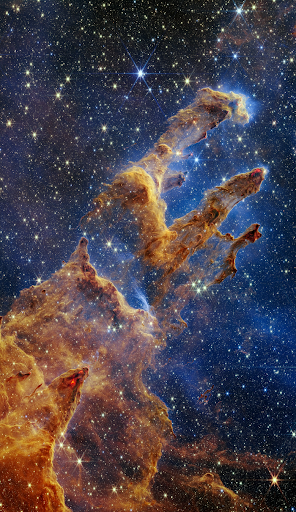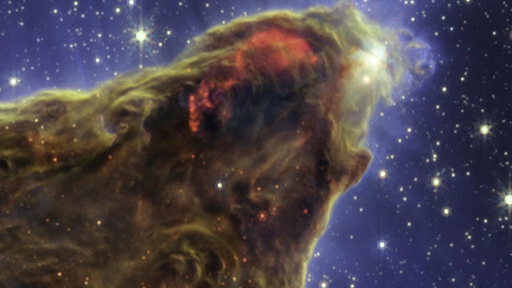December 13, 2022

By: AEOP Membership Council Members Prarthana Prashanth, Gabriel Acuff and Katie Culbert
The James Webb Space Telescope, NASA’s successor to the Hubble telescope, has captured, in a striking medley of color, the incredible “Pillars of Creation.” As the largest and most powerful optical telescope ever launched, the Webb’s infrared detector allows scientists to view the activity of new suns being formed.
Located in the Eagle Nebula, 6,500 light-years away from Earth, the Pillars of Creation serves as the birthplace of stars deep within dense clouds of gas and dust. First made famous in 1995 by NASA’s Hubble Space Telescope, Webb’s new view of the Pillars reveals cosmic processes never observed and increases NASA’s understanding of the formation of stars.
Pillars of Creation
Located within the heart of Eagle Nebula (also known as Messier 16), each pillar stretches approximately four to five light years. An active star-forming region, the structure’s lava-like edges are ejections of stars that have been formed out of gas and dust. NASA states, “the bright red orbs that typically have diffraction spikes and lie outside one of the dusty pillars are newly formed stars, while the wavy lines that look like lava at the edges of some pillars are ejections from stars that are still forming…when knots with sufficient mass form within the pillars of gas and dust, they begin to collapse under their own gravity, slowly heat up and eventually form new stars.” The young stars in the NIRCam image are estimated to be only a few hundred thousand years old.

James Webb Space Telescope (Webb, JWST)
Launched on December 25, 2021, the mission of the $10 billion James Webb Space Telescope is to study the earliest stars and continue the exploration of the Hubble Space Telescope. Armed with a much larger primary mirror than the Hubble (2.7 times larger in diameter, or about 6 times larger in area), Webb possesses much more light-gathering power. Because of its longer wavelength coverage and greatly improved sensitivity, JWST can look deep into dust clouds and capture stars and planetary systems forming today. Some features of Webb include the Near Infrared Camera (NIRCam), the Near-Infrared Spectrograph (NIRSpec), the Mid-Infrared Instrument (MIRI), and the Fine Guidance Sensor/ Near InfraRed Imager and Slitless Spectrograph (FGS-NIRISS). JWST is an international program led by NASA with its partners, ESA (European Space Agency) and CSA (Canadian Space Agency).
What’s Next
In a new surprising breakthrough, NASA reports Webb has discovered a cluster of massive galaxies in the process of forming around an extremely red quasar. A quasar is a compact region with a supermassive black hole at the center of a galaxy. The quasar, called SDSS J165202.64+172852.3, existed 11.5 billion years ago.
As a successor to Webb, NASA is planning a Wide-Field Infrared Survey Telescope (WFIRST), a space observatory designed to explore exoplanet and dark energy research and advance topics ranging from galaxy evolution to the study of objects within our own galaxy. WFIRST will be a wide-field-of-view near-infrared space telescope that will observe hundreds or thousands of supernovas and millions of galaxies. WFIRST is expected to launch in 2027.
References:
Find a Volunteering Opportunity
Visit our Program Volunteers page for a tool to find the best opportunity for you.
eCYBERMISSION Mini-Grant
The eCYBERMISSION Mini-Grant is intended to support teachers/program leaders as they implement eCYBERMISSION with their teams. Educators (formal and informal) of students in grades 6-9 are encouraged to apply.
